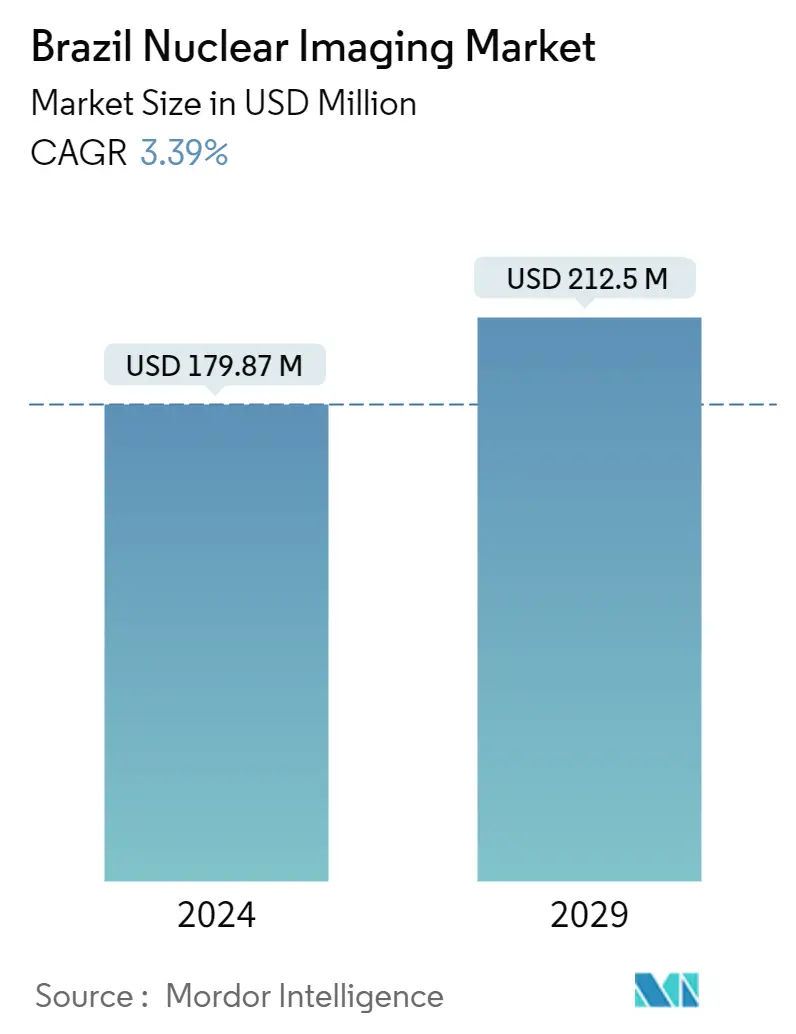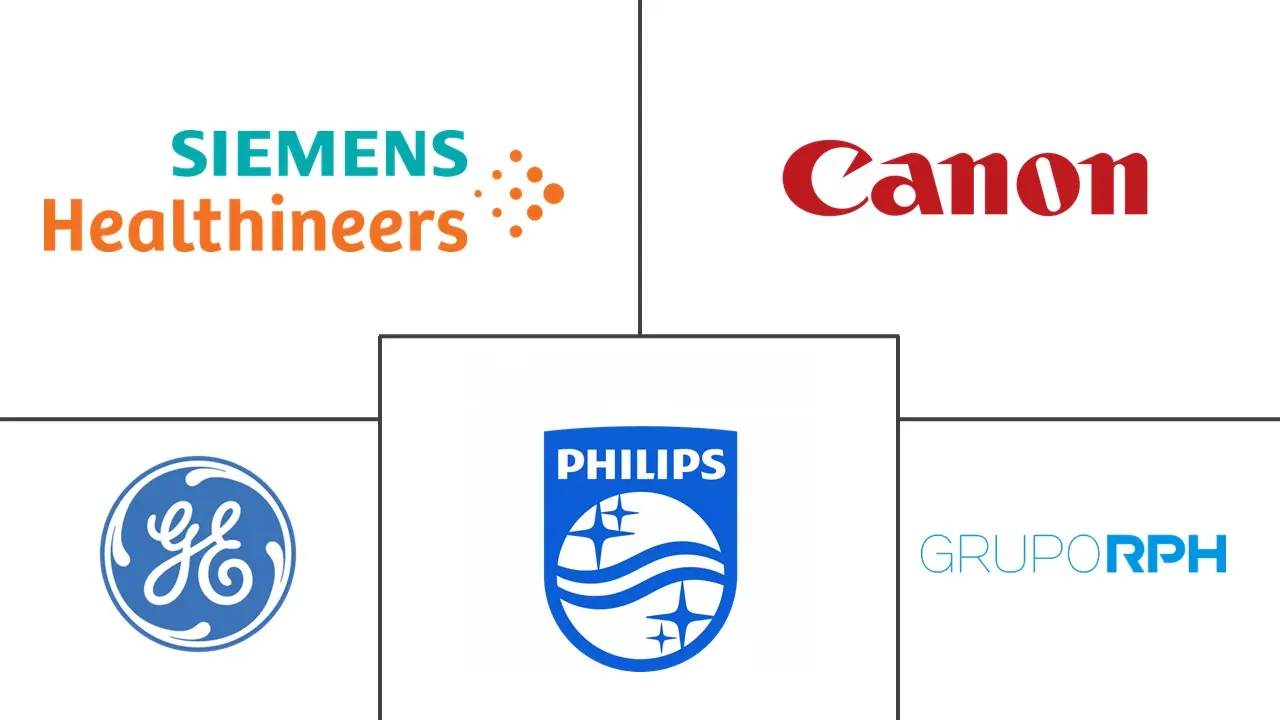Market Size of Brazil Nuclear Imaging Industry

| Study Period | 2019 - 2029 |
| Base Year For Estimation | 2023 |
| Market Size (2024) | USD 179.87 Million |
| Market Size (2029) | USD 212.50 Million |
| CAGR (2024 - 2029) | 3.39 % |
| Market Concentration | Medium |
Major Players
*Disclaimer: Major Players sorted in no particular order |
Brazil Nuclear Imaging Market Analysis
The Brazil Nuclear Imaging Market size is estimated at USD 179.87 million in 2024, and is expected to reach USD 212.5 million by 2029, growing at a CAGR of 3.39% during the forecast period (2024-2029).
The pandemic had an adverse effect on the country. Cancer patients were particularly affected by these activities since the length of time needed for screens, diagnoses, and treatment beginning had a negative impact on outcomes. Brazil's Ministry of Health (MoH) established an Emergency Operations Centre (COE) in January 2020 to respond to potentially affected cases, educate medical personnel nationwide, and offer tests and clinical practice recommendations. The Oswald Cruz Foundation (Fiocruz), the Pan American Health Organization (PAHO), and Anvisa (the Brazilian Health Regulatory Agency-Agencia Nacional de Vigilancia Sanitaria) made up the COE (PAHO). The COVID-19 scenario has also given market participants numerous possibilities to fortify their positions and acquire a competitive edge through strategic partnerships, mergers, or acquisitions. For instance, in June 2021, Isotope JSC, a division of Rusatom Healthcare JSC, Rosatom's radiation technologies integrator, agreed to a five-year supply agreement for lutetium-177 and actinium-225, the two most promising medical isotopes in radiopharma, with Brazil's Nuclear and Energy Research Institute. The agreement enhances ROSATOM's position as the main provider of radioisotopes to the markets in Latin America. Thus, the market was adversely affected by the pandemic.
Brazil is expected to contribute to the market's expansion due to the increased prevalence of diseases, technical advancements, the introduction of novel radiopharmaceuticals for diagnosis, and the development of molecular imaging. Additionally, almost 10% of all hospital admissions in Brazil are related to cardiovascular disorders, according to a report published in June 2020 with the title "Characterization of Brazilian hospital admissions owing to cardiovascular diseases: a longitudinal study." It also came to the conclusion that a significant portion of hospital admissions related to cardiovascular diseases are caused by stroke (11.4%), heart failure (21.3%), and other ischemic heart disorders (13.3%). The SPECT technique, which employs thallium-201 (201Tl), is preferable for the evaluation of cardiac perfusion and the integrity of the cellular membrane, according to the "Update of the Brazilian Guideline on Nuclear Cardiology - 2020" published in SciELO Brasil in February 2020. Such recommendations and guidelines are anticipated to accelerate market expansion. Eckert & Ziegler began shipping Technetium-99 generators to Brazil in August 2021. The Brazilian health agency ANVISA recently granted a license to the subsidiary Eckert & Ziegler Brasil Comercial Ltda., making it the first and only private company authorized to import and sell technetium generators. The first clients include two renowned hospitals in the greater Sao Paulo region. . Around 500 hospitals and clinics in the nation receive their medical supplies and radioisotopes from Eckert & Ziegler. Thus, the abovementioned factors are expected to increase market growth.
However, the lack of proper reimbursement and stringent regulatory approval procedures, and the high cost of equipment, are expected to hinder the market growth in Brazil.
Brazil Nuclear Imaging Industry Segmentation
As per the scope of the report, nuclear medicine imaging procedures are non-invasive, with the exception of intravenous injections, and are usually painless medical tests that help physicians diagnose and evaluate medical conditions. These imaging scans use radioactive materials called radiopharmaceuticals or radiotracers. These radiopharmaceuticals are used in diagnosis and therapeutics. They are small substances that contain a radioactive substance that is used in the treatment of cancer, cardiac and neurological disorders. Brazil Nuclear Imaging Market is segmented by Product (Equipment, and Diagnostic Radioisotope (SPECT Radioisotopes, and PET Radioisotopes), Application (SPECT Application (Cardiology, Neurology, Thyroid, and Other SPECT Applications), and PET Application (Oncology, Cardiology, Neurology, and Other PET Applications). The report offers the value (in USD million) for the above segments.
| By Product | ||||
| Equipment | ||||
|
| By Application | ||||||
| ||||||
|
Brazil Nuclear Imaging Market Size Summary
The Brazil nuclear imaging market is poised for growth, driven by an increase in disease prevalence, technological advancements, and the introduction of novel radiopharmaceuticals. The market is expected to expand as molecular imaging techniques and SPECT methods gain traction, particularly for cardiovascular assessments. The COVID-19 pandemic initially disrupted the market, affecting cancer patient outcomes and prompting the establishment of an Emergency Operations Centre by Brazil's Ministry of Health. However, the pandemic also created opportunities for strategic partnerships and supply agreements, such as the one between Isotope JSC and Brazil's Nuclear and Energy Research Institute, enhancing the availability of critical medical isotopes. The entry of companies like Eckert & Ziegler, which received regulatory approval to import and sell technetium generators, further underscores the market's potential for growth.
Despite the promising outlook, the market faces challenges, including high equipment costs, stringent regulatory approvals, and inadequate reimbursement frameworks. These factors could impede growth, even as the demand for PET and SPECT scans rises due to the increasing incidence of chronic diseases. The market is moderately competitive, with key players such as GE Healthcare, Siemens Healthineers AG, and Canon Inc. leading the charge. Collaborative efforts, like the one between Grupo RPH and OncoBeta GmbH, along with advancements in clinical applications, are expected to drive future market expansion. The establishment of facilities like the InsCer Diagnostic Center, which offers advanced PET scans, highlights the ongoing developments in Brazil's nuclear imaging sector.
Brazil Nuclear Imaging Market Size - Table of Contents
-
1. MARKET DYNAMICS
-
1.1 Market Overview
-
1.2 Market Drivers
-
1.2.1 Increasing Prevalence of Chronic Diseases
-
1.2.2 Rising Geriatric Population
-
1.2.3 Increasing Technological Advancements
-
-
1.3 Market Restraints
-
1.3.1 Lack Of Proper Reimbursement And Stringent Regulatory Approval Procedures
-
1.3.2 High Cost of Equipment
-
-
1.4 Porter's Five Force Analysis
-
1.4.1 Threat of New Entrants
-
1.4.2 Bargaining Power of Buyers/Consumers
-
1.4.3 Bargaining Power of Suppliers
-
1.4.4 Threat of Substitute Products
-
1.4.5 Intensity of Competitive Rivalry
-
-
-
2. MARKET SEGMENTATION (Market Size by Value - USD million)
-
2.1 By Product
-
2.1.1 Equipment
-
2.1.2 Diagnostic Radioisotope
-
2.1.2.1 SPECT Radioisotopes
-
2.1.2.2 PET Radioisotopes
-
-
-
2.2 By Application
-
2.2.1 SPECT Application
-
2.2.1.1 Cardiology
-
2.2.1.2 Neurology
-
2.2.1.3 Thyroid
-
2.2.1.4 Other SPECT Applications
-
-
2.2.2 PET Application
-
2.2.2.1 Oncology
-
2.2.2.2 Cardiology
-
2.2.2.3 Neurology
-
2.2.2.4 Other PET Applications
-
-
-
Brazil Nuclear Imaging Market Size FAQs
How big is the Brazil Nuclear Imaging Market?
The Brazil Nuclear Imaging Market size is expected to reach USD 179.87 million in 2024 and grow at a CAGR of 3.39% to reach USD 212.50 million by 2029.
What is the current Brazil Nuclear Imaging Market size?
In 2024, the Brazil Nuclear Imaging Market size is expected to reach USD 179.87 million.

